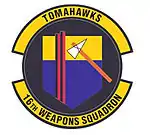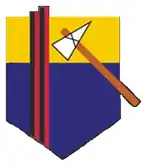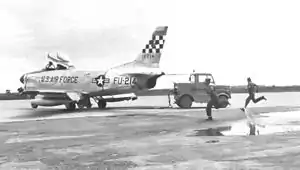16th Weapons Squadron
The 16th Weapons Squadron is a United States Air Force unit. It is assigned to the USAF Weapons School, based at Nellis Air Force Base, Nevada.
| 16th Weapons Squadron | |
|---|---|
 | |
| Active | 1940–Current |
| Country | |
| Branch | |
| Role | Advanced Fighter Training |
| Part of | Air Combat Command |
| Garrison/HQ | Nellis AFB, Nevada |
| Nickname(s) | Flying Wall (WW II) Tomahawks |
| Tail Code | "WA" |
| Engagements | Southwest Pacific Theater China Burma India Theater Korean War[1] |
| Decorations | Distinguished Unit Citation Air Force Outstanding Unit Award (5x) Republic of Korea Presidential Unit Citation (2x)[1] |
| Insignia | |
| 16th Weapons Squadron emblem[1] |  |
| 16 Fighter-Interceptor Sq emblem (approved 16 November 1961)[2] |  |
| 16th Fighter Sq emblem (World War II)[3] | _emblem.png.webp) |
The 16th began as the 16th Pursuit Squadron on 20 November 1940. During World War II, the 16th Squadron flew missions in New Guinea, India, and China in the Curtiss P-40 Warhawk, Republic P-47 Thunderbolt, and North American P-51 Mustang. During the Korean War, the 16th Fighter-Interceptor Squadron flew missions from Korea and Japan in the Lockheed F-80 Shooting Star and North American F-86 Sabre. After the Korean War, the 16th was stationed in Japan, Taiwan, Florida, Norway, Turkey, Korea, and Utah, flying missions in the Convair F-102 Delta Dagger and McDonnell F-4 Phantom II aircraft.
In January 1979, the 16th Tactical Fighter Training Squadron became the USAF's first F-16A/B operational squadron.
History
World War II

Activated at Hamilton Field, California in 1941 as a Curtiss P-40 Warhawk pursuit squadron to defend the West Coast. Deployed to the CBI in March 1942, initially arriving at Karachi, India moving via Australia and Ceylon. It was assigned to Tenth Air Force. The squadron defended the Indian terminus of The Hump over the Himalayas between India and China and airfields in that area, operating from the Assam Valley of northeast India. The squadron flew strafing, bombing, reconnaissance, and patrol missions in support of Allied ground troops during a Japanese offensive in northern Burma in 1943.
Moved to southeast China in October 1943, being assigned to Fourteenth Air Force. The squadron defended the Chinese end of the Hump route and air bases in the Kunming area. Attacked Japanese shipping in the Red River delta of Indochina and supported Chinese ground forces in their late 1944 drive along the Salween River. Was reequipped with North American P-51D Mustangs in 1945 to defend the eastern end of the route over the Hump, and to guard air bases in the Kunming area.
They returned to India in the fall of 1945 and sailed for the United States in November. Inactivated on 13 December 1945.
Air defense in the Pacific


Reactivated at Yontan Air Base Okinawa in 1946 and moved to Naha Air Base when Yontan closed in 1947. The squadron was assigned to the 301st Fighter Wing. Pilots engaged in combat operations in the Korean War, 1950–1953, returned to Naha Air Base to resume air defense coverage of the Ryukyu Islands in 1954.
From August 1958 to January 1959, deployed to Tainan Air Base Taiwan to fly combat air support missions for Nationalist Chinese forces after mainland Communist Chinese forces shelled the Nationalist-held islands of Quemoy and Matsu.
In the early 1960s, the Air Force was implementing Project Clearwater, an initiative to withdraw Convair F-102 Delta Daggers from overseas bases in order to reduce "gold flow" (negative foreign currency transactions).[4] By 1963, part of Clearwater called for the 16th to move to Davis-Monthan Air Force Base, Arizona,[note 5] permitting the McDonnell F-101 Voodoos of the 15th Fighter-Interceptor Squadron stationed there to be distributed to other Air Defense Command squadrons. However, the Gulf of Tonkin incident intervened and the 16th was kept in the Pacific to maintain an air defense capability there.[5] It deployed F-102s to the Philippines and South Vietnam from August to October 1964 for air defense against possible North Vietnamese air attacks.
Tactical fighter operations
Returned to the United States, activating at Eglin Air Force Base, Florida. Became combat ready in the McDonnell F-4 Phantom II aircraft in December 1965 with a program of tactical training operations to maintain proficiency. Participated in numerous airpower demonstrations, provided close air support of Army troops during tactical exercises, and prepared for overseas deployments.
From December 1966 to mid-1967 performed F-4 replacement training. Through deployment of combat-ready tactical components, with personnel and equipment transferred to Pacific Air Forces units upon arrival, the squadron provided fresh aircraft and aircrews for the forces in Southeast Asia, twice relinquished all its resources for combat and remanned in October 1967 and April 1969. Deployed to South Korea, and assumed alert status at Kunsan Kunsan and Osan Air Bases June–September 1970, providing air defense, participating in exercises, and maintaining combat readiness.
Moved to Hill Air Force Base, Utah, and received first production General Dynamics F-16A Fighting Falcon aircraft to be delivered to an operational squadron on 6 January 1979. Many of the early F-16 pilots went through the 16th Tactical Fighter Training Squadron, as it was the first Replacement Training Unit for the F-16 and acted as a worldwide training unit, training over 240 pilots in the F-16.
In April 1983 the unit became the 16th Tactical Fighter Squadron but still kept its training role, although not for beginner pilots but for higher levels of combat training. It was only fitting that as the world's first F-16 squadron that the 16th received the 1,000th F-16 to come off the General Dynamics assembly line on 22 July 1983. During the three years of operational tasking the squadron continued to train and upgrade its pilots to combat ready status and to maintain the capability to deploy worldwide on short notice and employ the F-16 in the conventional air-to-air and air-to-ground combat roles. The unit inactivated on 30 June 1986.
Fighter weapons training

Initially there was an F-16 division within the Fighter Weapons School that was created in 1982 and produced its first graduating class. The purpose of the school was to train aircrew in a most realistic combat environment.
Reactivated on 3 February 2003 as the 16th Weapons Squadron. The squadron is composed of block 42 and 52's. Only a few days before on 24 January 2003 the squadron officially was redesignated the 16th Weapons Squadron while working towards activation at Nellis Air Force Base, Nevada.
Lineage
- Constituted as the 16th Pursuit Squadron (Interceptor) on 20 November 1940
- Activated on 15 January 1941
- Redesignated: 16th Pursuit Squadron (Fighter) on 12 March 1941
- Redesignated: 16th Fighter Squadron (Twin Engine) on 15 May 1942
- Redesignated: 16th Fighter Squadron (Single Engine) on 1 June 1942
- Redesignated: 16th Fighter Squadron, Single Engine on 20 August 1943
- Inactivated on 7 December 1945
- Activated on 15 October 1946
- Redesignated 16th Fighter Squadron, Jet Propelled on 19 February 1947
- Redesignated 16th Fighter Squadron, Jet on 19 August 1948
- Redesignated 16th Fighter-Interceptor Squadron on 1 February 1950
- Discontinued and inactivated, on 24 December 1964
- Redesignated 16th Tactical Fighter Squadron and activated, on 18 June 1965 (not organized)
- Organized on 20 June 1965
- Inactivated on 1 November 1970
- Redesignated 16th Tactical Fighter Training Squadron on 3 October 1978
- Activated on 1 January 1979
- Redesignated 16th Tactical Fighter Squadron on 1 April 1983
- Inactivated on 30 June 1986
- Redesignated 16th Weapons Squadron on 24 January 2003
- Activated on 3 February 2003[1]
Assignments
- 51st Pursuit Group (later 51st Fighter Group), 15 January 1941 – 7 December 1945 (attached to 23d Fighter Group July 1942 – October 1943)
- 51st Fighter Group (later 51st Fighter-Interceptor Group), 15 October 1946 (attached to 51st Fighter-Interceptor Wing after 1 July 1957)
- 51st Fighter-Interceptor Wing, 25 October 1957 – 24 December 1964
- 33d Tactical Fighter Wing, 20 June 1965 – 1 November 1970 (attached to Tactical Air Forces Norway,[6] 27 August-13 September 1966; 1 Tactical Air Force (Turkish),[6] 13–31 October 1969; 354th Tactical Fighter Wing, 26 May-14 June 1970; 54th Tactical Fighter Wing, 15 June-7 September 1970)
- 388th Tactical Fighter Wing, 1 January 1979 – 30 June 1986
- USAF Weapons School, 3 February 2003 – present[1]
Stations
|
|
Aircraft
|
|
See also
References
Notes
- Explanatory notes
- Aircraft is General Dynamics F-16C Block 52, serial 93-553 at night with the Las Vegas "Strip" in the background. The aircraft sits after being loaded and prepared for a night training flight.
- Aircraft is Republic P-47D-30-RA Thunderbolt, serial 44-90248 at Yontan Airfield, Okinawa, 1946.
- Aircraft is North American F-86D-35-NA Sabre serial 51-6214, assigned to Naha Air Base, Okinawa, shown at Chia-Yi Afld, Taiwan, 1955.
- Aircraft is Convair F-102A-75-CO Delta Dagger serial 56-1377 at Naha AB, Okinawa, 1964.
- The original plan was to move the 16th to Edwards Air Force Base, but military construction costs to base the squadron there were prohibitive, so Davis-Monthan was selected. McMullen, pp. 60–61
- Citations
- Bailey, Carl E. (4 January 2008). "Factsheet 16 Weapons Squadron (ACC)". Air Force Historical Research Agency. Retrieved 1 May 2018.
- Maurer, Combat Squadrons, pp. 89–90
- Watkins, p. 30
- McMullen, p. 51
- McMullen, pp. 63–64
- NATO headquarters.
Bibliography
![]() This article incorporates public domain material from the Air Force Historical Research Agency.
This article incorporates public domain material from the Air Force Historical Research Agency.
- Maurer, Maurer, ed. (1983) [1961]. Air Force Combat Units of World War II (PDF) (reprint ed.). Washington, DC: Office of Air Force History. ISBN 0-912799-02-1. LCCN 61060979. Retrieved 17 December 2016.
- Maurer, Maurer, ed. (1982) [1969]. Combat Squadrons of the Air Force, World War II (PDF) (reprint ed.). Washington, DC: Office of Air Force History. ISBN 0-405-12194-6. LCCN 70605402. OCLC 72556. Retrieved 17 December 2016.
- McMullen, Richard F. (1964) "The Fighter Interceptor Force 1962-1964" ADC Historical Study No. 27, Air Defense Command, Ent Air Force Base, CO (Confidential, declassified 22 March 2000)
- Ravenstein, Charles A. (1984). Air Force Combat Wings, Lineage & Honors Histories 1947–1977. Washington, DC: Office of Air Force History. ISBN 0-912799-12-9. Retrieved 17 December 2016.
- Watkins, Robert A. (2017). Insignia and Aircraft Markings of the U.S. Army Air Force in World War II. Vol. VI, China-Burma-India & The Western Pacific. Atglen,PA: Shiffer Publishing, Ltd. ISBN 978-0-7643-5273-7.



.jpg.webp)
.png.webp)